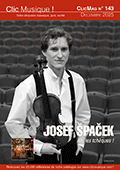 Un trio de Franz Schubert jeune précède un divertimento de Wolfgang Amadeus Mozart en pleine maturité. Est-ce à dire qu’il faille établir une comparaison ? Ce ne serait pas juste envers Schubert, pour plusieurs raisons : d’abord parce que mécontent de son travail, il n’achève pas son trio. Ensuite parce que si dans le domaine du Lied, il a trouvé sa voie, ce n’est pas le cas pour la musique de chambre. On n’entend pas la signature sonore du jeune Schubert dans ce trio, comme sera le cas pour ses œuvres ultérieures, tels que les quatuors. Mais ne boudons pas notre plaisir, ce trio est fort agréable à entendre. Le divertimento de Mozart, n’a de cette forme musicale que la présence d’un nombre important de mouvements. Nommé aussi cassation, ce genre instrumental plutôt léger, comprenant des danses -ici deux menuets-, se trouve ici revisité par le compositeur qui ne peut s’empêcher -pour notre bonheur- d’en proposer une vision personnelle, et savante. On relèvera le bel andante avec thème et variations, forme chère à Haydn et rarement poussée aussi loin par Mozart. (Lothaire Mabru)  Franz Schubert (1792–1828) only ever completed one string trio, his Trio in B flat D581 (1817). The writing is clearly inspired by the works of Mozart, not from a great trio like the Divertimento KV563, but from easier and made-for-piano genres like the violin sonatas. The cello, in fact, still remains in the orbit of the basso continuo, while the viola accompanies the main theme with formulas similar to the Alberti bass. Schubert's spark, however, is present in this minor work, for example in his way of dilating time at the beginning of the development with a phrasing that stretches, with simplicity, to infinity. The writing reveals a glimmer of the orchestral sound of the great chamber works of the last period, but nevertheless it remains linked to the elegant style of the late 18th century. Wolfgang Amadeus Mozart’s (1756–1791) Divertimento in E flat KV564 (1788) was written for Michael Puchberg, a music lover who often financially supported Mozart in the last years of his life. The work bears the clear imprint of Masonic symbology, based around the number 3. The Divertimento presents several enigmatic aspects, firstly the choice of title. ‘Divertimento’, like cassation or serenade, was a genre of music entertainment, without intellectual ambitions or strong emotions. In Divertimento KV563, the three musicians must be high-level virtuosos to play their parts, which explore the full register of each instrument in a dialogue intertwined with contributions at the same level from the three participants. The only link with the traditional genre is the high number of movements (six), including two minuets. In this piece, Mozart’s writing shows an extraordinary richness with respect to thematic invention, with an overabundance of ideas that feed a dense polyphonic dialogue. Mozart was experimenting with a fusion between the forms of instrumental music and the dramaturgy of his plays, with revolutionary results in both fields. The dynamism of the theatre, for example, is an essential element of the fluid liveliness of this Divertimento’s sonata. The slow movement represents another point of contact with the work, and this Adagio, the expressive heart of the work, is structured like a great solo aria. Mozart chose the key of A flat major, rare in his music and always ambassador of special moments, to express the melancholy of this world. In certain moments, the intensity of the singing becomes so dramatic as to go beyond the boundaries of tonal language. Furthermore, the Masonic number has an almost obsessive importance in the writing, with counterpoints in three parts and variations in triplets. The spirit of Masonic Enlightenment is concentrated in the austere sonority of the minor variation, manifesting compassion and the detachment of true wisdom. The form of both the rondo and the sonata blend into an architecture of perfect proportions, developed in a movement full of grace and energy. There are two thematic elements – a lively Italian dance and a contrasting episode of vague militaristic tone. This material feeds an always alive and changing form, enriched by new harmonic ideas and ingenious transitions.
 |
